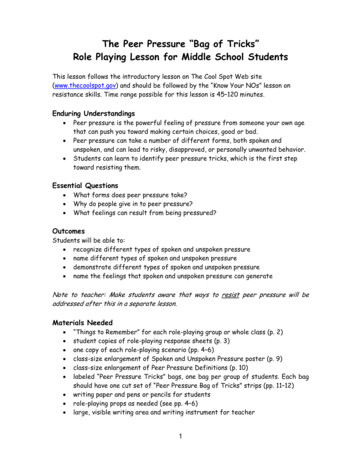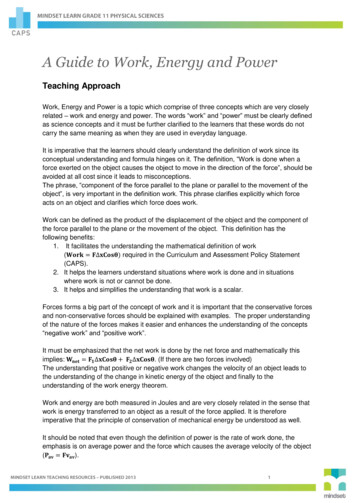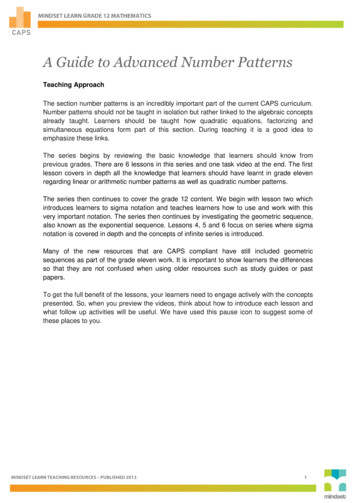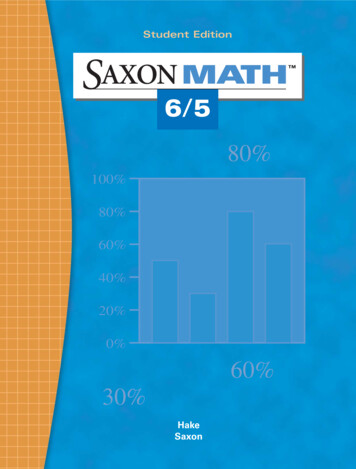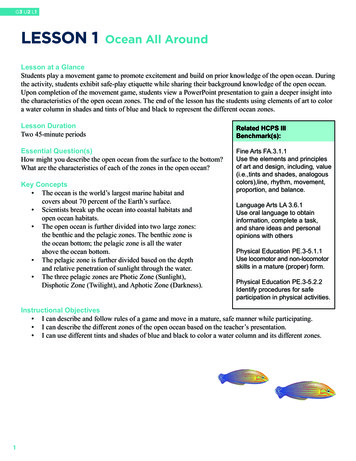
Transcription
G3 U2 L1LeSSON 1Ocean All AroundLesson at a GlanceStudents play a movement game to promote excitement and build on prior knowledge of the open ocean. Duringthe activity, students exhibit safe-play etiquette while sharing their background knowledge of the open ocean.Upon completion of the movement game, students view a PowerPoint presentation to gain a deeper insight intothe characteristics of the open ocean zones. The end of the lesson has the students using elements of art to colora water column in shades and tints of blue and black to represent the different ocean zones.Lesson DurationTwo 45-minute periodsRelated HCPS IIIBenchmark(s):Essential Question(s)How might you describe the open ocean from the surface to the bottom?What are the characteristics of each of the zones in the open ocean?Fine Arts FA.3.1.1Use the elements and principlesof art and design, including, value(i.e.,tints and shades, analogouscolors),line, rhythm, movement,proportion, and balance.Key Concepts The ocean is the world’s largest marine habitat andcovers about 70 percent of the Earth’s surface. Scientists break up the ocean into coastal habitats andopen ocean habitats. The open ocean is further divided into two large zones:the benthic and the pelagic zones. The benthic zone isthe ocean bottom; the pelagic zone is all the waterabove the ocean bottom. The pelagic zone is further divided based on the depthand relative penetration of sunlight through the water. The three pelagic zones are Photic Zone (Sunlight),Disphotic Zone (Twilight), and Aphotic Zone (Darkness).Language Arts LA 3.6.1Use oral language to obtaininformation, complete a task,and share ideas and personalopinions with othersPhysical Education PE.3-5.1.1Use locomotor and non-locomotorskills in a mature (proper) form.Physical Education PE.3-5.2.2Identify procedures for safeparticipation in physical activities.Instructional Objectives I can describe and follow rules of a game and move in a mature, safe manner while participating. I can describe the different zones of the open ocean based on the teacher’s presentation. I can use different tints and shades of blue and black to color a water column and its different zones.1
G3 U2 L1Assessment ToolsBenchmark Rubric:TopicHow the Arts are OrganizedUse the elements and principles of art and design,including, value (i.e., tints and shades, analogouscolors), line, rhythm, movement, proportion, andbalanceBenchmark FA.3.1.1RubricAdvancedConsistently use theelements and principles ofart and design, including,value, line, rhythm,movement, proportion, andbalanceProficientUsually use the elementsand principles of art anddesign, including, value,line, rhythm, movement,proportion, and balanceTopicProficientPartially ProficientUse oral language to obtain Use typical oral languageinformation, complete athat sometimes aids intask, and share ideas and obtaining information,personal opinions withcompleting a task, orotherssharing ideas and personalopinions with othersTopicProficientUsually use locomotor andnon-locomotor skills in amature (proper) formTopicPartially ProficientSometimes use locomotorand non-locomotor skills ina mature (proper) formNoviceRarely use locomotor andnon-locomotor skills in amature (proper) formSafety and Play EtiquetteIdentify procedures for safe participation in physicalactivitiesBenchmark PE.3-5.2.2RubricAdvancedExplain why a variety ofdifferent procedures helpkeep people safe duringparticipation in physicalactivitiesNoviceUse inappropriate orallanguage that does not aidin obtaining information,completing a task, orsharing ideas and personalopinions with othersFundamental SkillsUse locomotor and non-locomotor skills in a mature(proper) formBenchmark PE.3-5.1.1RubricAdvancedConsistently use locomotorand non-locomotor skills ina mature (proper) formNoviceRarely use the elementsand principles of art anddesign, including, value,line, rhythm, movement,proportion, and balanceDiscussion and PresentationUse oral language to obtain information, complete atask, and share ideas and personal opinions with othersBenchmark LA.3.6.1RubricAdvancedUse creative oral languageto obtain information,complete a task, andshare ideas and personalopinions with others, in ahighly effective wayPartially ProficientSometimes use theelements and principles ofart and design, including,value, line, rhythm,movement, proportion, andbalanceProficientIdentify procedures for safeparticipation in physicalactivitiesPartially ProficientName a procedure thatkeeps people safe duringphysical activitiesNoviceSelect from a list ofprocedures that keeppeople safe during physicalactivitiesAssessment/Evidence PiecesLesson Student participation in “Have You Ever?” Game Ocean Zones Poster2
G3 U2 L1Materials NeededTeacher Chart paper Book to read aloudMarine HabitatsLife in Saltwater, bySalvatore Tocci Method to presentPowerPoint Optional: colorwheelClass NoneGroup NoneStudent Sticky notes (1 perstudent) 8.5” x 11” whitepaper Tape (3 pieces) Blue and blackcrayons, paints orcolored pencils in avariety of shades Index cards MarkersInstructional ResourcesTeacher Reading: Zones of the OceanTeacher Reading: “Have You Ever?” QuestionsPowerPoint Presentation: The Open OceanSupplemental Resource: Open Ocean Habitats Interactive GameStudent Vocabulary Wordsaphotic or “darkness” zone: bottom most layer of the pelagic zone, where light does not reach.benthic zone: the ocean floor.disphotic or “twilight” zone: the poorly lit zone of the ocean below the photic zone.habitat: a place in which organisms live.oceanic zone: the deep water of the open sea beyond the continental shelf.open ocean: deep ocean waters that are not close to land masses.pelagic zone: the open ocean.photic or “sunlight” zone: the upper zone of the ocean with enough sunlight for plants to survive.3
G3 U2 L1Lesson PlansLesson Preparation Review the Science Background provided in the Unit’s Overview, and the Teacher Reading Zones ofthe Ocean. Preview the Teacher Reading “Have You Ever?” Questions and have it ready for use during the game. Preview the PowerPoint The Open Ocean and make arrangements to project it. Prepare the materials for the activities. Prepare a piece of chart paper by titling it “Wonderings about the Open Ocean” and placing it in thefront of the classroom. Preview the interactive piece Open Ocean Habitats to be completed at the end of Step II.I. “Have You Ever?” Pre-assessment GameA. Tell students they will be playing a movement game that enables them to move safely in an enclosedarea like various marine animals. Solicit from students why it is important to follow game rules andetiquette, especially while moving in an enclosed area.1) Some expectations which correlate with the physical education benchmarks are:a. Listen carefully to the teacher for instructions on how to move.b. Keep eyes looking forward so as not to bump into other students.c. Stay within the designated area for the game.d. Be aware of the space and people around you.e. Move carefully and slowly.2) Have children stand in a circle about arms-length apart. Pass out a Post-it note to each student. Havethem stick it to the ground to mark their spot for the game.3) Use a globe, and trace around the oceans with your finger to show students that all the oceans areconnected into one big ocean. Point out that the Pacific Ocean covers almost half of the globe.B. Explain the game rules for Have You Ever?1) Stand in the middle of the circle and explain to the class that you will be asking them a series ofquestions (listed in the Teacher Reading section for this lesson). If a student can answer YES to anyof the questions, he/she must move in the direction indicated by the teacher, to a new spot. (Forexample: hop on one foot, swim like a fish, move like a shark, crawl like a crab, and others.)2) Once students have found their new space in the circle, the teacher will ask reflection questions forchildren to elaborate, and share why they were able to move to the new space. Note: This is a time toclarify any of the students’ misconceptions, build on prior knowledge, and do an informal assessmentof what the students already know about the open ocean.C. Play the Have You Ever? Game using the questions provided on the Teacher Reading sheet at the back ofthis lesson as a guide to facilitate the flow of the game.D. After the game, have students return to their seats. Tell students that you have been asking them variouswondering questions, and now it is their turn to do so. Give each student an index card to write an “Iwonder ” question that they have about the open ocean. Tape these questions to a piece of chart paper4
G3 U2 L1entitled Wonderings about the Open Ocean and work with the students to categorize their questions (i.e.animal structure/function, animal behavior, plants, water quality, etc.).E. As students share their wonderings, explain that this is exactly what scientists do. They have questions,and wonder about them. They may do background research to gather more information and refine theirquestions. They then make an educated guess or hypothesis and design an experiment which can enablethem to seek an answer to their question. They conduct their experiment, and test their hypothesis todetermine if their data supports or refutes their hypothesis. Finally, they write a conclusion, which is anexplanation based on the data and evidence gathered during their investigation. Tell students that theywill be studying about the open ocean habitat and some of the organisms (animals) that live there.II. Marine HabitatsA. Read aloud: Marine Habitats Life in Saltwater, by Salvatore Tocci, pages 1–20 (if available) or anothercomparable book.B. Present The Open Ocean PowerPoint. Refer to the teacher notes on the slides when presenting.C. Discuss and review the different ocean zones following the presentation. Elicit from students what willhappen with the light as they go down deeper into the ocean water. How are the “Sunlight” zone and“Twilight” zones different? Will there be sharp changes in light, or will it gradually fade? If a colorwheel is available, you can show students the different shades and tints of blue and black. Make theconnection between the color and the light in the ocean zones slowly fading.D. Explain that during this lesson and the next lesson of this Open Ocean unit, the students’ task will beto create a water column poster and place various organisms into the appropriate habitat zone. The firststep is for students to use different shades of blue-to-black to color the background of the water columnposter. The next lesson will cover the addition of organisms.E. In order to reinforce the various zones of the open ocean and what organisms live in each zone, have thestudents work in pairs on the computer using the Open Ocean Habitats Interactive Game.III. Water Columns of the OceanA. Work with students to develop a criteria checklist for this first part of the Ocean Zones poster. (Since thisposter will be added upon in subsequent lessons, it may not completely meet the Fine Arts benchmark.This poster will be the start of the work needed to meet the indicated benchmark.)B. There are several suggested ways to complete the Ocean Zones poster. One method is to distribute threepieces of white paper to each student, and have them tape the pieces together vertically, so that theyform a long column. Label the three sections: Photic Zone (Sunlight), Disphotic Zone (Twilight), andAphotic Zone (Darkness).C. Have students color their columns with tempera paint, crayons, colored pencils, computer, or any othermedia that will enable students to create gradients of color.1) Start with light blue in the middle of the column and progressively add white to create tints of blueuntil the top is a white tinged with blue. Then starting with basic blue, again, progressively add blackto create gradual shades until the bottom is a blue-black.5
G3 U2 L1“Sunlight” zone“Twilight” zone“Darkness” zone2) The first 200 meters (600 feet) is called the “sunlight” zone, where the sun is able to penetrate. Thedeeper one goes in the ocean, the darker it becomes. Make sure students portray this by coloring thewater column darker and darker as it progresses through the “twilight” zone and the “darkness” zone.*Computer option example and directions:1. In Microsoft Word , insert a table and resize it to the desired height. Students will need 3 rowsand 2 columns.2. Resize the first column to the desired width.3. Insert an autoshape. Select the rectangle tool and draw a rectangle over the first column of thetable.4. Right-click on the shape you drew and click on Format AutoShape from the menu that pops up.5. Click on the bar next to the word color and click on Fill Effects. (This choice is next to the colorbar in Word 2007)6. Click on Two Colors and choose the two colors you want to use, blue and black.7. Click on horizontal and pick the gradient that starts from blue and ends with black on the bottom.8. Click on OK.9. This will give you a chart similar to the one shown above. Have the students save their WaterColumn file and you can add images to it in the next lesson.6
G3 U2 L1D. After students complete their water columns, have a few volunteers come up and show their workto the class. Student volunteers will need to describe each column or zone by giving its name and acharacteristic of that zone. Students will then hand in the water column assignment so that the teachercan hold on to them until the next lesson.Extended Activities1. You may want to incorporate these resources: http://sanctuaries.noaa.gov/education/welcome.html http://seawifs.gsfc.nasa.gov/ocean planet.htmlThe Ocean Planet site is a companion exhibit to the Smithsonian Institution’s National Museum ofNatural History traveling exhibition.2. You may want to add the following books to your classroom library for the duration of this unit: Wells, S. (1991). The Illustrated World of Oceans. Rockefeller Center: Simon & Schuster. Cole, J. (1994). The Magic School Bus On The Ocean Floor. New York: Scholastic. Maestro, B. (1997) A Sea Full of Sharks. New York: Scholastic. Demi. (1991). Find Demi’s Sea Creatures. New York: Putnam & Grosset. Armour, R. (1989). Sea Full Of Whales. New York: Scholastic. Selberg, I & McGuinness, D. (1990). Secrets of the Deep. New York: Dial Books for Young Readers. Steele, P. & Camm, M. (1991) Sharks and Other Creatures of the Deep. New York: DorlingKindersley Inc. Lionni, L. (1968). Swimmy. (New York), Pantheon Books, a division of Random House. Carle, Eric. (1990). A House for Hermit Crab, New York, Orchard Books.7
G3 U2 L1LeSSON 1Teacher ReadingZones of the OceanOceans and SeasThe Earth’s seawater is one continuous mass. The largest expanses of water are called oceans, and the smallerones partly enclosed by land are called seas. Seventy percent of the Earth’s surface is covered by seawater.The Pacific Ocean covers about one-third of the Earth’s surface, and is the largest and deepest ocean. Seawateris constantly moving. These marine currents are huge rivers of water that flow through the oceans. Some ofthese currents are warm; some are cold. Some currents run along the surface of the ocean; others run below thesurface.Ocean ZonesAll the water above the seafloor is called the pelagic zone. Scientists have further divided the pelagic zone intosmaller zones. Most sea creatures live in the upper two layers of the ocean: photic zone and the disphotic zone(also called sunlight and twilight zones).The layers of ocean can be divided into different “zones.” The photic zone receives the most sunlight andextends down to about 200 meters (656 feet). Below this zone is the disphotic zone, which gets some sunlight,and reaches approximately 200 to 1000 meters (656 to 3281 feet). This zone is dimly lit and less crowded thanthe photic zone. The photic zone is the only layer in which plants can live, and therefore has the most oxygen.Below the disphotic zone is the aphotic zone which extends from 1000 meters (3281 feet) to the ocean floor.The deepest known ocean trench is approximately 11,034 meters (36,000 feet). The seawater at this depth is incomplete darkness in frigid temperatures. The actual depths that the individual zones begin and end will dependon how deep sunlight can travel in a particular area (affected by water clarity). However, general depths can beused which describe the average depths that these zones begin and end.[For ease in student understanding, the terms “sunlight,” “twilight,” and “darkness” zones are used to describethe different zones based on the amount of sunlight it receives. You may choose to use those terms or the photic,disphotic, and aphotic vocabulary depending on your class.]8
G3 U2 L1LeSSON 1Teacher Reading“have You ever?” questions(Use this as a guide to facilitate the Have You Ever? Game.)I. Have you ever been out on a boat in the ocean? If so, move to another space by swimming like a fish.REFLECTION QUESTIONS:a. What did the ocean look like?b. How did you feel when you were out on the boat?c. Could you see land?d. Did you see any interesting marine animals or fish while on the boat?II.Move spaces like a shark if you have ever been diving down to the bottom of a pool, or ocean bottom.REFLECTION QUESTIONS:a. What did the bottom look like?b. What did it look like when you looked up?c. How did you feel while underwater?III. Move spaces like a crab if you have ever been on top of a mountain.REFLECTION QUESTION:What did it look like when you looked down from the top of the mountain?Note: Use this time to share with the class that the ocean bottom is not flat, but has mountainsand valleys (trenches) like on land.IV.Have you ever seen a * ? If so, move like them to a new space.REFLECTION QUESTIONS:a. How did they (animal/fish) look?b. How did they (animal/fish) move?c. Where did you see them? What were they doing (animal/fish)?*Fill in the blank space with one open ocean animal at a time. Examples of animals from variouszones in the open ocean are: pelagic [jack (ulua), dolphinfish (mahimahi), opahs, tunas and skipjack(’ahi and aku), flying fish, marlin, sharks and manta rays, dolphins, turtles, jellyfish, seals, whales];mesopelagic [anglerfish, rattails, seadevils, hatchetfish, lanternfish, viperfish]9
connection between the color and the light in the ocean zones slowly fading. D. Explain that during this lesson and the next lesson of this Open Ocean unit, the students’ task will be to create a water column poster and p







